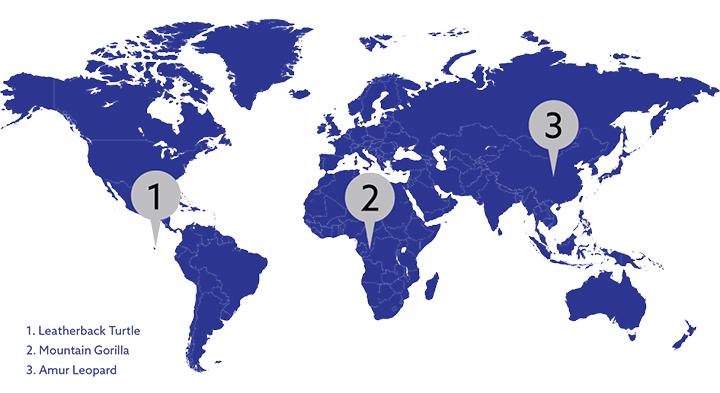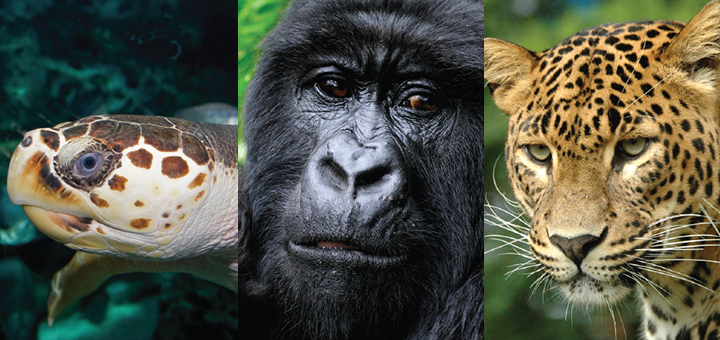We’ve got everything you want,” said the seller on the phone to the new buyer.
“Excellent! When can I come and look at them?”
“Meet me at midnight tonight outside my warehouse. You will be able to properly inspect your newly acquired animals when we get there.”
“Great! See you—”
“Just a moment,” said the seller. “I have one rule. Do not bring anyone with you. My business caters to higher-end consumers, and I want my clients to feel safe and protected from the rest of the world. There are individuals who don’t approve of this type of business. Understand?”
“Yes, I completely understand.”
Later that night, while the buyer was inspecting his newly acquired species, his eyes sparkled as he looked into each of the crates holding the animals that would soon be his.
“I’ll take them all!” said the buyer. “Now I have my own Amur leopard, leatherback turtle, mountain gorilla, and a green turtle! How were you able to acquire these animals so soon?”
“I can’t tell you my sources. All I can say is I have other clients who wanted similar animals for their own collections,” replied the seller.
This is just a sample of the conversations that can occur between a seller and a buyer of international endangered animals. There are several reasons why sellers go to such lengths to capture them. The first is money; these animals are highly sought after because of their rarity. The second reason is trading the animal—alive or dead—for useful objects such as utensils. The third reason is making clothing for higher paying consumers. The fourth reason is using the animals for construction or using parts of them for food.
According to the World Wildlife Fund organization, there are about 100 million different species on the earth. However, the extinction rate is about 0.01 percent per year, or about 10,000 species per year. Amur leopards, leatherback turtles, and mountain gorillas are all considered to be critically endangered.
Native to Asian regions, the Amur leopard’s population has dwindled to 30. The number of leatherback turtles, which can be found in the Galapagos Islands, is unknown at the present time. There are only 880 mountain gorillas left in the African Congo Basin. Swift foxes, found along the Great Plains of North America, are losing their homes due to human interference.

What Can We Do?
While these animals are indeed at high risk of extinction, we can help by slowing down the rate at which they are dying off. The World Wildlife Fund website (worldwildlife.org) provides many opportunities for potential environmentalist and animal rights activists to help.
Visitors can learn about endangered species and their environments and participate in fundraising by shopping on the site or making a donation.
In addition the World Wildlife Fund lists about 12 pages of projects they are involved in, and how to be a part of them.
Currently, the organization is discussing the trade of ivory and how there needs to be more regulations. They are asking individuals to sign an electronic letter that will ensure these elephants remain in the thoughts of representatives of the United States Congress and the Fish and Wildlife Service. Another way individuals and animal rights activists can get involved with the World Wildlife Fund is to join their membership.
We have the responsibility to take care of these creatures and their homes. According to the first chapter in Genesis, God gave Adam and Eve the responsibility to look after the animals to protect them in the Garden of Eden. Gen. 6:19-20 says, “You are to bring into the ark two of all living creatures, male and female, to keep them alive with you. Two of every kind of bird, of every kind of animal and of every kind of creature that moves along the ground will come to you to be kept alive. You are to take every kind of food that is to be eaten and store it away as food for you and them.” Noah was being instructed by God to gather two of every kind and place them in the ark before the flood came. By doing this Noah and his family were able to save and help regrow the animal population after the flood had passed. In Matt. 6:26 Jesus says, “Look at the birds of the air; they do not sow or reap or store away in barns, and yet your heavenly Father feeds them.”
It’s Time for Change
After reading these passages from the Bible I began to wonder. What is stopping us from helping? Is it our own mindset that someone else will take up the responsibility in protecting these species? Why can’t we take a stand against others who want to kill these innocent animals to make a profit? The World Wildlife Fund is helping the world in answering these questions, so what are we willing to do?
This article was also published in the February 2015 print edition of OUTLOOK, our annual special issue written and designed by Union College students. It was written by Courtney Grant, a junior communication major from Lincoln, Nebraska. The print version was designed by Dakota Youngberg, a junior international rescue and relief major from Temecula, California.










